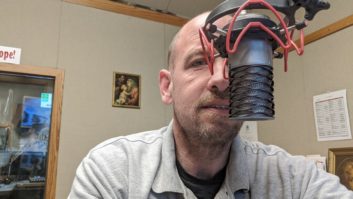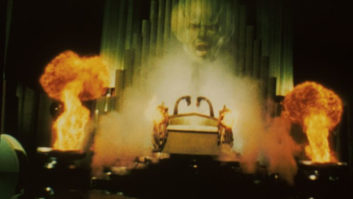Photos
(click thumbnail)Fig. 1: The Goose is compact and will fit nicely in the back of a rack.
(click thumbnail)Fig. 2: Software links the Goose to a computer or the Web.
(click thumbnail)Fig. 3: Larger UPS’s have a sensitivity adjustment.
We’re approaching the time of year when access to transmitter sites may be restricted by the weather. Gary Wachter of Service Broadcasting in Dallas came upon a useful discovery while searching for a transmitter site humidity sensor. A company called IT Watchdogs Inc. manufactures innovative monitoring tools. Their site is www.itwatchdogs.com.
The basic $199 WeatherDuck measures temperature, humidity and air flow. The sensor terminates on
a DB-9 connector that is plugged into the serial port of a computer. Client software is run for monitoring.
The company has some other products with strange names, including the WeatherGoose and SuperGoose. These products have additional sensor inputs and connect to the network to be viewed on a Web browser.
Additional sensors such as AC power monitoring, current loops, airflow and temperature plug into RJ-45 connectors using the Dallas Semiconductor 1 wire system. Contact closure inputs are also available for door sensors or relay closures. A Webcam can be attached for a snapshot view.
The data is charted and recorded with one-month storage capacity. Alarms can be set and an e-mail sent upon tripping.
Gary installed the SuperGoose at KRNB(FM), one of his more distant transmitter sites. As seen in Fig. 1, it occupies one rack unit and is about 2 inches deep. It’s easily hidden in the back of a rack.
In addition to the internal sensors, Gary added a temperature airflow sensor and placed it in front of the main A/C exhaust grill. It soon revealed a problem with the A/C. It turned out that the airflow rates were swinging wildly due to the coils freezing. The temp sensor on the existing remote control showed just the normal average temperature.
The only shortfall with the device is that it is “monitoring” only. There are no alarm or control outputs (except an internal buzzer). But its monitoring capabilities have freed up a couple of positions on the transmitter remote control. Fig. 2 shows the monitoring software operating on the KRNB computer.
Not only is the device great for the transmitter site, but Gary suggests adding one to the studio rack room or server room.
Gary Wachter is director of engineering for Service Broadcasting.
* * *
At a recent nuts-and-bolts discussion at an SBE conference, the issue of a UPS not accepting generator power came up. Elmer Goetsch is chief engineer at WXPR(FM) in Rhinelander, Wis. He encountered a similar problem a few years ago.
Elmer installed a 5 kW Generac natural gas backup generator at the WXPR studios, where he has quite a number of APC UPS’s, including a large one powering critical on-air equipment, similar to that shown in Fig. 3.
What Elmer discovered was that nearly all recent (and larger) APC units have a “sensitivity” switch. This is usually a “dip” or pushbutton switch assembly that is accessible through the back panel. Desensitizing the UPS solved the problem.
WXPR’s 2 kW APC UPS is fairly old and lacked the sensitivity adjustment. Elmer was able to get it to accept the noisy Generac waveform by installing a Kleen Line Isolator-Conditioner on the UPS input. It removed enough of the noise to make the UPS happy. Electronic Specialists is a distributor of Kleen Line conditioners. You’ll find them at www.elect-spec.com/klr_$.htm
* * *
Bill Bowin is the market chief for North American Broadcasting’s stations in Columbus, Ohio. He experienced an extended power failure (>16 hours) at the main transmitter site, and operated from the backup site during this time.
However, when power returned, the main transmitter didn’t. The transmitter was a 1988 Harris 20K2. It turned out that the transmitter’s phase monitor relay wouldn’t close.
This sensing relay will keep a transmitter off the air if any of the three electrical phases of AC power are missing. Although these relays are great for protecting transmitters against electrical phase loss, they are not tied into the transmitter alarm system, so unless you know it’s there, you can spend hours searching for why the transmitter won’t turn on.
As it turns out, this particular phase monitor relay, which Bill points out is similar to but not manufactured by SSAC, contains a 160 volt/33uF electrolytic capacitor that had dried out. Bill had replaced all the electrolytics in this rig previously but was unaware that this capacitor existed.
Bill repaired the old relay and ordered a new one to have on the shelf. You can bet that he’ll be checking other time delay and phase monitor relays for these “hidden” capacitors. Bill’s “shotgun” approach to replacing all the old electrolytics in his transmitter is a good idea.
After about seven years, the electrolytic material will dry out; failure will result. There are certainly cases where these capacitors will last longer, but the stresses these components are under — from power spikes, inrush currents or surges — make them a major point of failure.
I remember one of the FCC Second Class License questions: “Which component has the highest failure rate?” Tubes, resistors, coils and capacitors were the choices. The correct answer was capacitors. Enough said!
So, as Bill suggests, when you’re troubleshooting check your voltages first, then look for that wayward electrolytic capacitor.















